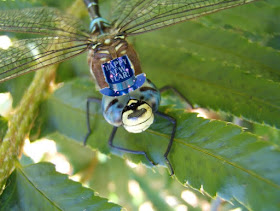The next species to grace the spotlight, the Canada Darner, is one that is not seen all that often—and when it
is spotted, it's often high up on a tree trunk. Another one of the mosaic darners, a group that that includes the Happy-face Darner (Paddle-tailed Darner), the Canada Darner is best known by its "notched" side stripes that look like slippers or clogs.
Here's a typical view of a Canada Darner, perched on the vertical surface of a light-colored tree trunk.

A closer look reveals simple appendages and cream-colored spots on the last segment 10 of the abdomen.

These features are consistent with both a Canada Darner and a Variable Darner, but the prominent front stripes on the thorax, and the robust stripe on the top of segment 2, indicate that the Canada Darner is the more likely identification. To be certain, though, we need to see the side stripes of the thorax.
The next photo shows another Canada Darner perched high in a tree. In this case, you can just barely see the notched shape of the side stripe through the front wing. This confirms the identification.

Here's a better look at the side stripes. Notice that the forward side stripe looks like a house slipper, or a clog, with the toes near the dragonfly's head. The rear side stripe is shaped like a short spike pointing forward.

A slightly closer view of the same individual:

We haven't seen this species in Anacortes, but it is seen occasionally at Barnaby Slough, high in the foothills of the Cascades. We see it on a more regular basis at the Beaver Pond near Sun Mountain Lodge in eastern Washington.
Find out more about this species, and the other mosaic darners, in my new field guide:
https://www.amazon.com/dp/1934199265/_encoding=UTF8?coliid=I2Z1AF74MM3GXS&colid=1F4EX3HT0YWX6&psc=0

















